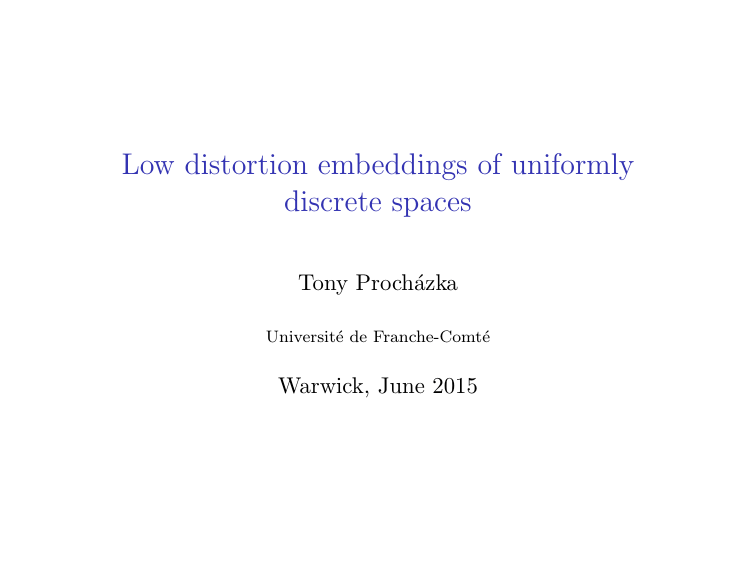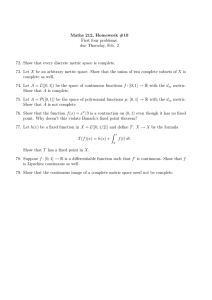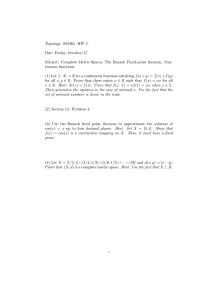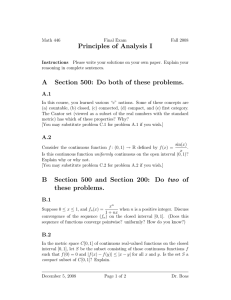Low distortion embeddings of uniformly discrete spaces Tony Proch´ azka
advertisement

Low distortion embeddings of uniformly
discrete spaces
Tony Procházka
Université de Franche-Comté
Warwick, June 2015
Definition ((M, d) metric, X Banach, D ≥ 1)
I
M ,→ X means ∃ f : M → X such that
D
d(x, y) ≤ kf (x) − f (y)k ≤ Dd(x, y).
Definition ((M, d) metric, X Banach, D ≥ 1)
I
M ,→ X means ∃ f : M → X such that
D
d(x, y) ≤ kf (x) − f (y)k ≤ Dd(x, y).
I
if moreover M is Banach and f is linear, write M ⊆ X.
D
Definition ((M, d) metric, X Banach, D ≥ 1)
I
M ,→ X means ∃ f : M → X such that
D
d(x, y) ≤ kf (x) − f (y)k ≤ Dd(x, y).
I
if moreover M is Banach and f is linear, write M ⊆ X.
D
Theorem (P., Sánchez-González, 2014)
There exists a countable metric graph M such that M ,→ X
implies `1 ⊆ X whenever D < 2.
D
Definition ((M, d) metric, X Banach, D ≥ 1)
I
M ,→ X means ∃ f : M → X such that
D
d(x, y) ≤ kf (x) − f (y)k ≤ Dd(x, y).
I
if moreover M is Banach and f is linear, write M ⊆ X.
D
Theorem (P., Sánchez-González, 2014)
There exists a countable metric graph M such that M ,→ X
implies `1 ⊆ X whenever D < 2.
D
The constant 2 is optimal as every separable metric space ,→ c0
2
(Kalton-Lancien).
Theorem (P., Sánchez-González, 2014)
There exists a countable metric graph M such that M ,→ X
implies `1 ⊆ X whenever D < 2.
D
Theorem (P., Sánchez-González, 2014)
There exists a countable metric graph M such that M ,→ X
implies `1 ⊆ X whenever D < 2.
D
Other non-linear sufficient conditions for `1 ⊆ X
I
`1 ,→ X and X has the RNP (Aronszajn, Christensen,
Mankiewicz)
Theorem (P., Sánchez-González, 2014)
There exists a countable metric graph M such that M ,→ X
implies `1 ⊆ X whenever D < 2.
D
Other non-linear sufficient conditions for `1 ⊆ X
I
`1 ,→ X and X has the RNP (Aronszajn, Christensen,
Mankiewicz)
I
`1 ,→ X and X is a dual (Heinrich, Mankiewicz)
Theorem (P., Sánchez-González, 2014)
There exists a countable metric graph M such that M ,→ X
implies `1 ⊆ X whenever D < 2.
D
Other non-linear sufficient conditions for `1 ⊆ X
I
`1 ,→ X and X has the RNP (Aronszajn, Christensen,
Mankiewicz)
I
`1 ,→ X and X is a dual (Heinrich, Mankiewicz)
I
f : `1 ,→ X and f surjective
Theorem (P., Sánchez-González, 2014)
There exists a countable metric graph M such that M ,→ X
implies `1 ⊆ X whenever D < 2.
D
Other non-linear sufficient conditions for `1 ⊆ X
I
`1 ,→ X and X has the RNP (Aronszajn, Christensen,
Mankiewicz)
I
`1 ,→ X and X is a dual (Heinrich, Mankiewicz)
I
f : `1 ,→ X and f surjective
I
`1 ,→ X (Godefroy, Kalton)
1
It is not known
I
whether `1 ,→ X implies `1 ⊆ X.
D<2
It is not known
I
whether `1 ,→ X implies `1 ⊆ X.
I
whether ∀ Y separable Banach ∃ C > 1 such that Y ,→ X
D<2
implies Y ⊆ X whenever D < C.
D
It is not known
I
whether `1 ,→ X implies `1 ⊆ X.
I
whether ∀ Y separable Banach ∃ C > 1 such that Y ,→ X
D<2
implies Y ⊆ X whenever D < C.
D
Our space M does not answer any of the above questions
because
I M ,→ `1 =⇒ D ≥ 2.
D
It is not known
I
whether `1 ,→ X implies `1 ⊆ X.
I
whether ∀ Y separable Banach ∃ C > 1 such that Y ,→ X
D<2
implies Y ⊆ X whenever D < C.
D
Our space M does not answer any of the above questions
because
I M ,→ `1 =⇒ D ≥ 2.
D
I
M ,→ F(M ) ' `1 .
1
It is not known
I
whether `1 ,→ X implies `1 ⊆ X.
I
whether ∀ Y separable Banach ∃ C > 1 such that Y ,→ X
D<2
implies Y ⊆ X whenever D < C.
D
Our space M does not answer any of the above questions
because
I M ,→ `1 =⇒ D ≥ 2.
D
I
M ,→ F(M ) ' `1 .
1
Remark
I
<ω
∞
The Hamming cube
equipped with the
1 = {0, 1}
PC
∞
distance d(x, y) = i=1 |xi − yi | does not help either as
C1∞ ,→ C([0, ω ω ]) (Baudier, Freeman, Schlumprecht, Zsak,
1+ε
2014).
It is not known
I
whether `1 ,→ X implies `1 ⊆ X.
I
whether ∀ Y separable Banach ∃ C > 1 such that Y ,→ X
D<2
D
implies Y ⊆ X whenever D < C.
Our space M does not answer any of the above questions
because
I M ,→ `1 =⇒ D ≥ 2.
D
I
M ,→ F(M ) ' `1 .
1
Remark
I
<ω
∞
The Hamming cube
equipped with the
1 = {0, 1}
PC
∞
distance d(x, y) = i=1 |xi − yi | does not help either as
C1∞ ,→ C([0, ω ω ]) (Baudier, Freeman, Schlumprecht, Zsak,
1+ε
2014).
I
On the other hand C1∞ ,→ X =⇒ `1 ⊆ X.
1
1
Consequences of the Theorem
I
Given a separable metric space N , we know that N ,→ c0
2
but does there exist an equivalent norm |·| on c0 such that
N ,→(c0 , |·|) for some D < 2?
D
Consequences of the Theorem
I
Given a separable metric space N , we know that N ,→ c0
2
but does there exist an equivalent norm |·| on c0 such that
N ,→(c0 , |·|) for some D < 2?
D
No!
Consequences of the Theorem
I
Given a separable metric space N , we know that N ,→ c0
2
but does there exist an equivalent norm |·| on c0 such that
N ,→(c0 , |·|) for some D < 2?
D
No!
I
Let K be a Hausdorff compact. Then C(K) is universal
(for separable metric spaces and Lipschitz embeddings with
distortion < 2) iff C(K) is linearly isometrically universal.
Consequences of the Theorem
I
Given a separable metric space N , we know that N ,→ c0
2
but does there exist an equivalent norm |·| on c0 such that
N ,→(c0 , |·|) for some D < 2?
D
No!
I
Let K be a Hausdorff compact. Then C(K) is universal
(for separable metric spaces and Lipschitz embeddings with
distortion < 2) iff C(K) is linearly isometrically universal.
Observation
S
Let M =↑ Mk for some finite sets (Mk ). Then ∀ D ∈ [1, 2),
ε > 0 and n ∈ M ∃ k ∈ N such that Mk ,→ X implies `n1 ⊆ X.
D
1+ε
Consequences of the Theorem
I
Given a separable metric space N , we know that N ,→ c0
2
but does there exist an equivalent norm |·| on c0 such that
N ,→(c0 , |·|) for some D < 2?
D
No!
I
Let K be a Hausdorff compact. Then C(K) is universal
(for separable metric spaces and Lipschitz embeddings with
distortion < 2) iff C(K) is linearly isometrically universal.
Observation
S
Let M =↑ Mk for some finite sets (Mk ). Then ∀ D ∈ [1, 2),
ε > 0 and n ∈ M ∃ k ∈ N such that Mk ,→ X implies `n1 ⊆ X.
D
1+ε
We are going to give a direct proof with estimates of the
constants for a particular choice of (Mn ).
The spaces Mn
I
Mn = {0} ∪ J1, nK ∪ Fn where Fn = 2J1,nK \ {∅}
The spaces Mn
I
I
Mn = {0} ∪ J1, nK ∪ Fn where Fn = 2J1,nK \ {∅}
a = 0 and b ∈ J1, nK
A pair {a, b} is an edge ⇔
or
a ∈ J1, nK, b ∈ Fn and a ∈ b.
The spaces Mn
I
I
Mn = {0} ∪ J1, nK ∪ Fn where Fn = 2J1,nK \ {∅}
a = 0 and b ∈ J1, nK
A pair {a, b} is an edge ⇔
or
a ∈ J1, nK, b ∈ Fn and a ∈ b.
I
Finally, we equip Mn with the shortest path metric.
Theorem (A)
Let D ∈ [1, 43 ) and n ∈ N. Then Mn ,→ X implies that `n1 ⊆ X
D
where D0 =
D
4−3D .
D0
Theorem (A)
Let D ∈ [1, 43 ) and n ∈ N. Then Mn ,→ X implies that `n1 ⊆ X
D
where D0 =
I
D0
D
4−3D .
Reduce D0 at the cost of augmenting the n of Mn using
Finite version of James’s `1 -distortion theorem
2
m
If `m
1 ⊆ X, then `1 ⊆ x.
b2
b
Theorem (A)
Let D ∈ [1, 43 ) and n ∈ N. Then Mn ,→ X implies that `n1 ⊆ X
D
where D0 =
I
D0
D
4−3D .
Reduce D0 at the cost of augmenting the n of Mn using
Finite version of James’s `1 -distortion theorem
2
m
If `m
1 ⊆ X, then `1 ⊆ x.
b2
b
We get
log(1+ε)
If D < 34 , ε > 0 and w ≥ − log2 ( log(
),
D
)
4−3D
then Mn2w ,→ X implies that `n1 ⊆ X.
D
1+ε
Theorem (B)
Let D ∈ [1, 2). ∀ α ∈ (0, 1) ∃ η = η(α, D) ∈ (0, 1) such that
2D
0
Mk ,→ X implies that `ηk
1 ⊆ X (with D = 2−D ) whenever
k>
D
2D
log2 ( 2−D
)+1
.
1−α
D0
Theorem (B)
Let D ∈ [1, 2). ∀ α ∈ (0, 1) ∃ η = η(α, D) ∈ (0, 1) such that
2D
0
Mk ,→ X implies that `ηk
1 ⊆0 X (with D = 2−D ) whenever
D
D
η
2D
log ( 2−D
)+1
will do.
k > 2 1−α
. Any η such that 2α ≥ ηe
Theorem (B)
Let D ∈ [1, 2). ∀ α ∈ (0, 1) ∃ η = η(α, D) ∈ (0, 1) such that
2D
0
Mk ,→ X implies that `ηk
1 ⊆0 X (with D = 2−D ) whenever
D
D
η
2D
log ( 2−D
)+1
will do.
k > 2 1−α
. Any η such that 2α ≥ ηe
Proof.
I
Assume f : Mk ,→ X, f (0) = 0.
D
Theorem (B)
Let D ∈ [1, 2). ∀ α ∈ (0, 1) ∃ η = η(α, D) ∈ (0, 1) such that
2D
0
Mk ,→ X implies that `ηk
1 ⊆0 X (with D = 2−D ) whenever
D
D
η
2D
log ( 2−D
)+1
will do.
k > 2 1−α
. Any η such that 2α ≥ ηe
Proof.
I
Assume f : Mk ,→ X, f (0) = 0.
I
For every A ∈ Fk =⇒ ∃ x∗A ∈ BX ∗ s.t.
hx∗A , f (a)i ≥ 4 − 2D + hx∗A , f (b)i ∀ a ∈ A, b ∈ J1, kK \ A.
D
Theorem (B)
Let D ∈ [1, 2). ∀ α ∈ (0, 1) ∃ η = η(α, D) ∈ (0, 1) such that
2D
0
Mk ,→ X implies that `ηk
1 ⊆0 X (with D = 2−D ) whenever
D
D
η
2D
log ( 2−D
)+1
will do.
k > 2 1−α
. Any η such that 2α ≥ ηe
Proof.
I
Assume f : Mk ,→ X, f (0) = 0.
I
For every A ∈ Fk =⇒ ∃ x∗A ∈ BX ∗ s.t.
hx∗A , f (a)i ≥ 4 − 2D + hx∗A , f (b)i ∀ a ∈ A, b ∈ J1, kK \ A.
I
Lemma. Let Γ be a set, (fi )ni=1 ⊂ KB`∞ (Γ) .
If ∃ r ∈ R, δ > 0 s.t. ∀ A ⊂ J1, nK, ∃ γ ∈ Γ
D
fi (γ) ≥ r + δ > r ≥ fj (γ),
then (fi ) is
2K
δ -equivalent
∀ i∈A,j∈J1,nK\A,
to the u.v.b. of `n1 .
Theorem (B)
Let D ∈ [1, 2). ∀ α ∈ (0, 1) ∃ η = η(α, D) ∈ (0, 1) such that
2D
0
Mk ,→ X implies that `ηk
1 ⊆0 X (with D = 2−D ) whenever
D
D
η
2D
log ( 2−D
)+1
will do.
k > 2 1−α
. Any η such that 2α ≥ ηe
Proof.
I
Assume f : Mk ,→ X, f (0) = 0.
I
For every A ∈ Fk =⇒ ∃ x∗A ∈ BX ∗ s.t.
hx∗A , f (a)i ≥ 4 − 2D + hx∗A , f (b)i ∀ a ∈ A, b ∈ J1, kK \ A.
I
Lemma. Let Γ be a set, (fi )ni=1 ⊂ KB`∞ (Γ) .
If ∃ r ∈ R, δ > 0 s.t. ∀ A ⊂ J1, nK, ∃ γ ∈ Γ
D
fi (γ) ≥ r + δ > r ≥ fj (γ),
then (fi ) is
I
2K
δ -equivalent
Find r and δ?!
∀ i∈A,j∈J1,nK\A,
to the u.v.b. of `n1 .
I
∀ A ∈ Fk ∃ jA ∈ J1, cK such that
hx∗A , f (a)i ≥ rjA +(2−D) > rjA ≥ hx∗A , f (b)i ,
∀ i∈A,j∈J1,nK\A.
I
∀ A ∈ Fk ∃ jA ∈ J1, cK such that
hx∗A , f (a)i ≥ rjA +(2−D) > rjA ≥ hx∗A , f (b)i ,
I
∃ j ∈ J1, cK such that |S| ≥
2k −1
c
∀ i∈A,j∈J1,nK\A.
for S = {A ∈ Fk : jA = j}.
I
∀ A ∈ Fk ∃ jA ∈ J1, cK such that
hx∗A , f (a)i ≥ rjA +(2−D) > rjA ≥ hx∗A , f (b)i ,
I
I
∃ j ∈ J1, cK such that |S| ≥
2k −1
c
∀ i∈A,j∈J1,nK\A.
for S = {A ∈ Fk : jA = j}.
Lemma (Sauer, Shelah, and Vapnik and Červonenkis) Let
m−1
X k J1,kK
S⊂2
such that |S| >
for some m ≤ k. Then
i
i=0
there is H ∈ J1,kK
such that {A ∩ H : A ∈ S} = 2H .
m
I
∀ A ∈ Fk ∃ jA ∈ J1, cK such that
hx∗A , f (a)i ≥ rjA +(2−D) > rjA ≥ hx∗A , f (b)i ,
I
I
∃ j ∈ J1, cK such that |S| ≥
2k −1
c
∀ i∈A,j∈J1,nK\A.
for S = {A ∈ Fk : jA = j}.
Lemma (Sauer, Shelah, and Vapnik and Červonenkis) Let
m−1
X k J1,kK
S⊂2
such that |S| >
for some m ≤ k. Then
i
i=0
there is H ∈ J1,kK
such that {A ∩ H : A ∈ S} = 2H .
m
I
|S| ≥
2k − 1
c
I
∀ A ∈ Fk ∃ jA ∈ J1, cK such that
hx∗A , f (a)i ≥ rjA +(2−D) > rjA ≥ hx∗A , f (b)i ,
I
I
∃ j ∈ J1, cK such that |S| ≥
2k −1
c
∀ i∈A,j∈J1,nK\A.
for S = {A ∈ Fk : jA = j}.
Lemma (Sauer, Shelah, and Vapnik and Červonenkis) Let
m−1
X k J1,kK
S⊂2
such that |S| >
for some m ≤ k. Then
i
i=0
there is H ∈ J1,kK
such that {A ∩ H : A ∈ S} = 2H .
m
I
|S| ≥
2k − 1
> 2αk
c
I
∀ A ∈ Fk ∃ jA ∈ J1, cK such that
hx∗A , f (a)i ≥ rjA +(2−D) > rjA ≥ hx∗A , f (b)i ,
I
I
∃ j ∈ J1, cK such that |S| ≥
2k −1
c
∀ i∈A,j∈J1,nK\A.
for S = {A ∈ Fk : jA = j}.
Lemma (Sauer, Shelah, and Vapnik and Červonenkis) Let
m−1
X k J1,kK
S⊂2
such that |S| >
for some m ≤ k. Then
i
i=0
there is H ∈ J1,kK
such that {A ∩ H : A ∈ S} = 2H .
m
I
2k − 1
|S| ≥
> 2αk ≥
c
e
η
ηk
I
∀ A ∈ Fk ∃ jA ∈ J1, cK such that
hx∗A , f (a)i ≥ rjA +(2−D) > rjA ≥ hx∗A , f (b)i ,
I
I
∃ j ∈ J1, cK such that |S| ≥
2k −1
c
∀ i∈A,j∈J1,nK\A.
for S = {A ∈ Fk : jA = j}.
Lemma (Sauer, Shelah, and Vapnik and Červonenkis) Let
m−1
X k J1,kK
S⊂2
such that |S| >
for some m ≤ k. Then
i
i=0
there is H ∈ J1,kK
such that {A ∩ H : A ∈ S} = 2H .
m
I
2k − 1
|S| ≥
> 2αk ≥
c
ek
ηk
ηk
I
∀ A ∈ Fk ∃ jA ∈ J1, cK such that
hx∗A , f (a)i ≥ rjA +(2−D) > rjA ≥ hx∗A , f (b)i ,
I
I
∃ j ∈ J1, cK such that |S| ≥
2k −1
c
∀ i∈A,j∈J1,nK\A.
for S = {A ∈ Fk : jA = j}.
Lemma (Sauer, Shelah, and Vapnik and Červonenkis) Let
m−1
X k J1,kK
S⊂2
such that |S| >
for some m ≤ k. Then
i
i=0
there is H ∈ J1,kK
such that {A ∩ H : A ∈ S} = 2H .
m
I
2k − 1
|S| ≥
> 2αk ≥
c
ek
ηk
dηke−1 ηk
>
X
i=0
k
i
I
∀ A ∈ Fk ∃ jA ∈ J1, cK such that
hx∗A , f (a)i ≥ rjA +(2−D) > rjA ≥ hx∗A , f (b)i ,
I
I
∃ j ∈ J1, cK such that |S| ≥
2k −1
c
∀ i∈A,j∈J1,nK\A.
for S = {A ∈ Fk : jA = j}.
Lemma (Sauer, Shelah, and Vapnik and Červonenkis) Let
m−1
X k J1,kK
S⊂2
such that |S| >
for some m ≤ k. Then
i
i=0
there is H ∈ J1,kK
such that {A ∩ H : A ∈ S} = 2H .
m
I
2k − 1
|S| ≥
> 2αk ≥
c
I
ek
ηk
dηke−1 ηk
>
X
i=0
k
i
=⇒ ∃H of cardinality dηke such that (f (i))i∈H is
dηke
2D
Q.E.D.
2−D -equivalent to the u.v.b. of `1
Final remarks
I
∀ D ≥ 1, ε > 0, Y, dim Y < ∞, ∃ F ⊂ Y finite s.t.
F ,→ X =⇒ Y ⊆ X.
D
D+ε
Final remarks
I
∀ D ≥ 1, ε > 0, Y, dim Y < ∞, ∃ F ⊂ Y finite s.t.
F ,→ X =⇒ Y ⊆ X.
D
I
Which F ????
D+ε
Final remarks
I
∀ D ≥ 1, ε > 0, Y, dim Y < ∞, ∃ F ⊂ Y finite s.t.
F ,→ X =⇒ Y ⊆ X.
D
D+ε
I
Which F ????
I
Denote Cpn = {−1, 1}n equipped with the metric
1
P
d(ε, ε0 ) = ( |εi − ε0i |p ) p .
Final remarks
I
∀ D ≥ 1, ε > 0, Y, dim Y < ∞, ∃ F ⊂ Y finite s.t.
F ,→ X =⇒ Y ⊆ X.
D
D+ε
I
Which F ????
I
Denote Cpn = {−1, 1}n equipped with the metric
1
P
d(ε, ε0 ) = ( |εi − ε0i |p ) p .
I
Let 1 ≤ p ≤ 2. Then ∀ n ∈ N, ε > 0, D ≥ 1 ∃ k ∈ N such
that Cpk ,→ X =⇒ `np ⊆ X.
D
1+ε
Final remarks
I
∀ D ≥ 1, ε > 0, Y, dim Y < ∞, ∃ F ⊂ Y finite s.t.
F ,→ X =⇒ Y ⊆ X.
D
D+ε
I
Which F ????
I
Denote Cpn = {−1, 1}n equipped with the metric
1
P
d(ε, ε0 ) = ( |εi − ε0i |p ) p .
I
Let 1 ≤ p ≤ 2. Then ∀ n ∈ N, ε > 0, D ≥ 1 ∃ k ∈ N such
that Cpk ,→ X =⇒ `np ⊆ X.
D
I
1+ε
How does k depend on (n, D, ε)?
Final remarks
I
∀ D ≥ 1, ε > 0, Y, dim Y < ∞, ∃ F ⊂ Y finite s.t.
F ,→ X =⇒ Y ⊆ X.
D
D+ε
I
Which F ????
I
Denote Cpn = {−1, 1}n equipped with the metric
1
P
d(ε, ε0 ) = ( |εi − ε0i |p ) p .
I
Let 1 ≤ p ≤ 2. Then ∀ n ∈ N, ε > 0, D ≥ 1 ∃ k ∈ N such
that Cpk ,→ X =⇒ `np ⊆ X.
D
I
1+ε
How does k depend on (n, D, ε)?
Thank you for your attention!




